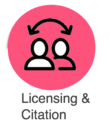Documentation:Open Case Studies/Resources
Here is our collection of shared resources for case study development.
General Case Study Resources
These general resources on writing case studies may be helpful to your process.
Case Studies in Higher Education
- Defining, Creating and Using Case Studies - Carnegie-Mellon University (Eberly Centre).
- Using Case Studies to Teach - Boston University
- Teaching With Case Studies - Stanford University
Writing Case Studies
- Writing Case Studies: Carnegie Mellon University.
- Case Writing Guide for Students - World Association for Case Method Research and Application (WACRA). Although written for students who are researching and preparing cases at a high level of detail - it contains useful information about types of cases and their purposes, ethical concerns and the 4 basic components of a case.
- Cases That Sing - WACRA - short piece highlighting the 4 ingredients for engaging cases.
- A Biased Opinion About Bias and Opinion - WACRA. A short piece describing how bias creeps into case writing and how to avoid it.
Student Guide to Writing Case Studies
- Ethics Case Writing Guidelines - Illinois Institute of Technology
Reviewing Case Studies
- Elements of the Review Ready Case - World Association for Case Method Research and Application
Wiki Support

|

|

|

| |
|---|---|---|---|---|
|
Question Boxes
- here is the mark up for a box that you can use to draw attention to questions that you want students to grapple with.
CIVL Resources
Civil Engineering case study
SiD definition of Sustainability
“Sustainability is a state of a complex, dynamic system. In this state a system can continue to flourish without leading to its internal collapse or requiring inputs from outside its defined system boundaries.
Applied to our civilization, this state is consistent with an equitable and healthy society, as well as thriving ecosystems and a beautiful planet.” [1]
SiD methods
SiD's method consists of cycle of actions that is usually cycled through several times during a project. The cycle can be entered at any point. It involves gathering experts from multi-disciplines for a short period of time (usually 5 days) in a single room where they envision, analyze, map, understand, invent, and evaluate in rapid cycles. [1]

ELSIA
SiD acknowledges three dimensions of impact: object level, network level and systematic level. Among the three dimensions, systematic level is the primary target for optimization because its impact is far greater than the other two levels. There are separate sets of indicators on each and together those indicators can be fed into the systematic level where sustainability can be measured.[1]
Below shows the set of indicators from the object level.

The spectrum, or ELSIA, provides a way for "systematic thinking" which allows users to map relationship between objects. It can be used for indicator selection, effect mapping and many other stages of systems analysis. In particular, ELSIA stands for: Energy & Materials (Matter), Life (Species & Ecosystems), Society (Economy & Culture), Individual (Health & Happiness), Actions (Utility & Purpose). The categories are intertwined. For example, Individuals are part of Society, Life is made of Energy and Materials and so on. [2]
Results
The results of SiD's methodology has been evaluated in the fields of business strategy, agriculture, the built environment, industry, knowledge management and policy development. SiD evaluates multiple aspects of sustainability which can be categorized into the following sectors:[1]
- People
(social justice, diversity, transparency of decision making and governance policies) - Nature
(biodiversity, ecosystems, capacity for value addition and safety) - Closed-loop metabolism
(circular economy, zero waste, water natural and toxin free) - Resilient systems
(ability of a system to handle sudden disruption) - Innovation
(multi-disciplinary setup promotes innovative solutions) - Bottom up strength, top-down strategy
What is a case study?
"Engineering Case", "Case", and "Case Study" are used loosely and interchangeably in engineering. An Engineering Case is: an account of an engineering activity, event or problem containing some of the background and complexities actually encountered by an engineer. A case is used in engineering courses to enhance learning about engineering principles and practices. [3]
Environmental ethics expands the study of ethics into the non-human world.[4]
Refrences
- ↑ 1.0 1.1 1.2 1.3 Symbiosis in Development (SiD), 2009.http://www.except.nl/nl/#.nl.articles.148-symbiosis-in-development-sid
- ↑ Symbiosis in Development: ELSIA.http://www.except.nl/en/#.en.articles.149-symbiosis-in-development-elsia
- ↑ http:www.libguides.vmi.edu/
- ↑ Wikipedia. Retrieved on April 16, 2016. Environmental Ethics. Retrieved on April 16, 2016 from: https://en.wikipedia.org/wiki/Environmental_ethics
ECON Resources
Resources for case studies
- B.C goundfish trawl fishery habitat agreement 2012-2016.
- Case written up in an article in '. 'Marine Policy, [1]
- Authors of the article awarded the Vancouver Aquarium- Coastal Ocean Research Institute 2016 Murray A. Newman Conservation Action Award
Then at all the other citation points, just enter:
Content[3]
Important Links:
- Research Paper- Dragging Our Assets: Toward an ecosystem approac to bottom trawling in Canada by Scott Wallace [4]
- Government of Canada Resources: "Integrated Fisheries Management Plans"[5]
- Research Paper: The Economics and Management of Word Fisheries. [6]


- ↑ Wallace, S., Turris, B., Driscoll, J., Bodtker, K., Mose, B., & Munro, G. (2015). Canada's pacific groundfish trawl habitat agreement: A global first in an ecosystem approach to bottom trawl impacts. Marine Policy, 60, 240-248. doi:10.1016/j.marpol.2015.06.028
- ↑ 2.0 2.1 Wikipedia. Retrieved on April 16, 2016. Environmental Ethics. Retrieved on April 16, 2016 from: https://en.wikipedia.org/wiki/Environmental_ethics
- ↑ 3.0 3.1 3.2 University of British Columbia. Retrieved on May 19th: http://www.calendar.ubc.ca/Vancouver/index.cfm?tree=12,304,933,0
- ↑ Wallace, S(2007).Dragging Our Assets: Toward an ecosystem approach to bottom trawling in Canada.David Suzuki Foundation. Retrieved on 19th May, 2016.
- ↑ Government of Canada, Integrated Fisheries Management Plans. Retrieved on 19th May, 2016 from: http://www.dfo-mpo.gc.ca/fm-gp/peches-fisheries/ifmp-gmp/index-eng.htm
- ↑ Bjørnland,T and Munro,Gordon(2012). The Economics and Management of World Fisheries. Oxford University Press.Volume: 28 (3), 305-306. Retrieved from: http://ezproxy.library.ubc.ca/login?url=http://gw2jh3xr2c.search.serialssolutions.com/?sid=sersol&SS_jc=TC0000834488&title=The%20economics%20and%20management%20of%20world%20fisheries
EOAS Resources
Case Study Subjects
- BC energy
- site C
- fracking
<ref name="eoas">
FRST Resources
Environmental NGOs
Human Rights NGOs
- ↑ Wikipedia. Environmental Ethics. Retrieved on April 16, 2016 from: https://en.wikipedia.org/wiki/Environmental_ethics
- ↑ /Muthu, Y., & Grzeszczyk, G. (2011). Analysis of the Australian and Canadian governments' aboriginal policies. AlterNative: An International Journal of Indigenous Peoples, 7(1), 15.
import links
- forest connect [Christina: I can't find the original for this image--I'm not sure we can use it.]






GEOG Resources
- Healey, M. and J. Roberts (2004) Engaging Students in Active Learning: Case Studies in Geography, Environment and Related Disciplines. School of Environment, University of Gloucestershire.
- McFarlane, D. A. (2015). Guidelines for using case studies in the teaching-learning process. College Quarterly, 18(1), 1.
General References on Case-based Learning
- Kolodner, J. L. (1993). Case-Based Learning. Boston, MA: Springer US. doi:10.1007/978-1-4615-3228-6[1]
- Claire Davis and Elizabeth Wilcock (nd) Teaching Materials Using Case Studies (website)
- Jeffrey A Gray (1999) How to get More out of case studies
References
- ↑ Kolodner, J. L. (1993). Case-Based Learning. Boston, MA: Springer US. doi:10.1007/978-1-4615-3228-6
Images for the Law Case Study

Video for the Introduction of the Case Study
Gateway: The Enbridge Northern Gateway Pipeline
A film by Ben Paull
Secondary Videos for Potential Use
Original Enbridge Nother Gateway Pipeline Route Animation
Citations
Question References
Aboriginal Rights
Borrows, John. "With or without you: First Nations law (in Canada)." McGill LJ 41 (1995): 629.
Why BC First Nations Oppose the Northern Gateway Pipeline https://www.thestar.com/news/atkinsonseries/2015/08/28/why-bc-first-nations-oppose-the-northern-gateway-pipeline.html
Case Study References
Northern Gateway. Project Outline. Retrieved on May 20, 2016 at http://www.gatewayfacts.ca/About-The-Project/Project-Overview.aspx
Additional Resources
Huff Article [1]
Huseman Article [2]
Urquhart Article[3]
Tar Sands and Indigenous lands: http://oilsandstruth.org/on-matter-tar-sands-amp-indigenous-lands
Preston Article [4]
O’Faircheallaigh Article [5]
Indigenous Foundations Website [6]
References
- ↑ Huff, A. (1991) Resource development and human rights: A look at the case of the Lubicon Cree Indian Nation of Canada. Colorado Journal of International Environmental Law and Policy. 10. 161. Retrieved on: http://ezproxy.library.ubc.ca/login?url=http://heinonline.org.ezproxy.library.ubc.ca/HOL/SelectPage?handle=hein.journals/colenvlp10&collection=journals&page=161
- ↑ Huseman, J. and Short, D. (2012) A slow industrial genocide’: tar sands and the indigenous peoples of northern Alberta. The International Journal of Human Rights 16 (1). 216-237. Retrieved from: http://ezproxy.library.ubc.ca/login?url=http://www-tandfonline-com.ezproxy.library.ubc.ca/doi/abs/10.1080/13642987.2011.649593
- ↑ Urquhart, I. (2010) Between the Sands and a Hard Place?: Aboriginal Peoples and the Oil Sands. Buffett Center for International and Comparative Studies Working Paper 10-005. 9-12. Retreived from: http://buffett.northwestern.edu/publications-projects/working-papers/energy/between-the-sands-and-a-hard-place.html
- ↑ Preston, J. (2013) Neoliberal settler colonialism, Canada and the tar sands. Race & Class 55 (2), 42-59. Retrieved from: http://ezproxy.library.ubc.ca/login?url=http://rac.sagepub.com.ezproxy.library.ubc.ca/content/55/2/42
- ↑ O’Faircheallaigh, C., and Ali, A., eds. (2008) Earth Matters : Indigenous Peoples, the Extractive Industries and Corporate Social Responsibility. Sheffield, South Yorkshire, GBR: Greenleaf Publishing. Retrieved from: http://site.ebrary.com/lib/ubc/detail.action?docID=10650094
- ↑ Indigenous Foundations. Home Page. Retrieved on May 20, 2016 at: http://indigenousfoundations.arts.ubc.ca/
LFS Resources
Citations
Agnoletti Article [1]
Gavin Article [2]
Buizer Article [3]
Frascaroli Article [4]
Nakamura Article [5]
Andersson Article [6]
Mackey, B and Claudie D. [7]
Jovel Article [8]
Backes Article [9]
Clavet-Mirab Article [10]
Pretty Article [11]
Frascaroli Article [12]
Elands Article [13]
References
- ↑ Agnoletti, M and Emanueli, F. (2016). Biocultural Diversity and Landscape in Europe: Framing the Issue, Volume (V). Page 1. Retrieved from: http://ezproxy.library.ubc.ca/login?url=http://download.springer.com/static/pdf/541/chp%253A10.1007%252F978-3-319-26315-1_1.pdf?originUrl=http%3A%2F%2Flink.springer.com%2Fchapter%2F10.1007%2F978-3-319-26315-1_1&token2=exp=1463690498~acl=%2Fstatic%2Fpdf%2F541%2Fchp%25253A10.1007%25252F978-3-319-26315-1_1.pdf%3ForiginUrl%3Dhttp%253A%252F%252Flink.springer.com%252Fchapter%252F10.1007%252F978-3-319-26315-1_1*~hmac=9243c725c146d6bed76b06dc5157088ef38d2a614d62d19e5b8559af99126a43 Buizer, M, Elands, B and Mattijssen, T. et.al. (2015). The governance of urban green spaces in selected EU-cities: Policies, Practices, Actors, Topics. Green Surge. Retrieved from: http://greensurge.eu/working packages/wp6/files/Buizer_et_al_2015_D6.1_GREEN_SURGE_The_governance_of_urban_green_spaces_in_selected_EU_cities.pdf
- ↑ C Gavin, M, McCarter, J, Mead, A. et.al. (2015). Defining biocultural approaches to conservation. Trends in Ecology and Evolution, Volume (30). Retrieved from: http://www.cell.com/trends/ecology-evolution/abstract/S0169-5347(15)00002-6
- ↑ Buizer, M, Elands, B and Vierikko, K. Governing cities reflexively-The biocultural diversity concept as an alternative to ecosystem services, Science Direct. Retrieved from: http://www.sciencedirect.com/science/article/pii/S1462901116300521
- ↑ Frascaroli, F, Frascaroli, F and Verschuuren, B. (2016). Biocultural Diversity in Europe. www.researchgate.net. Springer. Retrieved from https://www.researchgate.net/publication/299751957_Linking_Biocultural_Diversity_and_Sacred_Sites_Evidence_and_Recommendations_in_the_European_FrameworkLinking_Biocultural_Diversity_and_Sacred_Sites_Evidence_and_Recommendations_in_the_European_Framewo
- ↑ Hashimoto, S, Nakamura, S, Saito, O. et.al. (2015). Mapping and characterizing ecosystem services of social-ecological production landscapes: case study of Noto Japan, Sustainability Science .Retrieved from: http://ezproxy.library.ubc.ca/login?url=http://ezproxy.library.ubc.ca/login?url=http://link.springer.com/article/10.1007%2Fs11625-014-0285-1
- ↑ Andersson, E and Barthel, S. (2016). Memory carriers and stewardship of metropolitan landscapes, Stockholm Resilience Centre. Retrieved from: http://ezproxy.library.ubc.ca/login?url=http://www.sciencedirect.com/science/article/pii/S1470160X16300516
- ↑ (2015). Points of Contact: Integrating Traditional and Scientific Knowledge for Biocultural Conservation, Environmental Ethics. Retrieved from: http://ezproxy.library.ubc.ca/login?url=https://www.pdcnet.org/collection/show?id=enviroethics_2015_0037_0003_0341_0357&file_type=pdf
- ↑ Jovel, Eduardo M., José Cabanillas, and G. H. N. Towers. "An ethnobotanical study of the traditional medicine of the Mestizo people of Suni Mirano, Loreto, Peru." Journal of ethnopharmacology 53.3 (1996): 149-156.
- ↑ Backes, Martina M. (2001) The role of indigenous trees for the conservation of biocultural diversity in traditional agroforestry land use systems: The Bungoma case study In-situ conservation of indigenous tree species . Agroforestry Systems. 52(1), 119-113. Retrieved from: http://ezproxy.library.ubc.ca/login?url=http://link.springer.com/article/10.1023%2FA%3A1010685317405
- ↑ Calvet-Mirab, L., Riue-Bosoma, C., González-Puentea, M. et. al. (2016). The Transmission of Home Garden Knowledge: Safeguarding Biocultural Diversity and Enhancing Social-Ecological Resilience. Society & Natural Resources: An International Journal, 29(5). Retrieved from: http://ezproxy.library.ubc.ca/login?url=http://www.tandfonline.com/doi/full/10.1080/08941920.2015.1094711
- ↑ Pretty, J., Adams, B. and Berkes, F. et. al. (2009). The Intersections of Biological Diversity and Cultural Diversity: Towards Integration. Conservation and Society. 7(2), 100-112. Retrieved from: http://www.conservationandsociety.org/article.asp?issn=0972-4923;year=2009;volume=7;issue=2;spage=100;epage=112;aulast=Pretty
- ↑ Frascaroli, F., Bhagwat, S. and Guarino, R. et. al. (May 2006). Shrines in Central Italy conserve plant diversity and large trees. Ambio, 45(4), 468-479. Retrieved from: http://ezproxy.library.ubc.ca/login?url=http://link.springer.com/article/10.1007%2Fs13280-015-0738-5
- ↑ Elands, B., Wiersum, K., and Buijs, A. et al. (2015). Policy interpretations and manifestation of biocultural diversity in urbanized Europe: conservation of lived biodiversity. Biodiversity and 24(130), 3347-3366. Retrieved from: http://ezproxy.library.ubc.ca/login?url=http://link.springer.com/article/10.1007/s10531-015-0985-6
Possible images
Here are some images of various plants at UBC to go through and see if any are useful. If any are, please let Christina Hendricks know and she can upload them to the wiki: c.hendricks@ubc.ca
- https://www.flickr.com/photos/gotovan/6271983056/
- https://www.flickr.com/photos/56866338@N06/5857875898/
- https://www.flickr.com/photos/probabilistic/5995378100/
- https://www.flickr.com/photos/56866338@N06/5857870002/
- https://www.flickr.com/photos/o_0/5648304541/
- https://www.flickr.com/photos/eekim/10255456275/
- https://www.flickr.com/photos/velkr0/3570224655/
- https://www.flickr.com/photos/randylandicho/14826309863/
- https://www.flickr.com/photos/rkeefer/163974053/
I found all of these using the following page and searching on “UBC." There are lots more:
https://www.flickr.com/creativecommons/by-2.0/
PHIL Resources
Ethics in World Politics Topics
Climate Justice
Articles
Henry Shue, "Subsistence Emissions and Luxury Emissions," Law and Policy 15:1 (January 1993).
Webpages
Images

Species Protection
Articles
Protection of Chimpanzees. The US banned experimentation on chimpanzees in 2015. [1]
Ban on Whaling: Regulating vs. banning whaling. [2]
References
- ↑ Charissa Echevez, "US Government Finally Banning Chimp Research," Science Times, November 23, 2015, accessed April 19, 2015
- ↑ Ian Hurd, "Almost Saving Whales: The Ambiguity of Success at the International Whaling Commission," Ethics and International Affairs [1], March 29, 2012, accessed May 17, 2016
